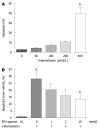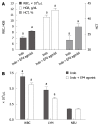EP4 agonist alleviates indomethacin-induced gastric lesions and promotes chronic gastric ulcer healing
- PMID: 19891013
- PMCID: PMC2773893
- DOI: 10.3748/wjg.15.5149
EP4 agonist alleviates indomethacin-induced gastric lesions and promotes chronic gastric ulcer healing
Abstract
Aim: To investigate EP4-selective agonist effect on indomethacin-induced gastric lesions and on the spontaneous healing of chronic gastric ulcers.
Methods: In a mouse model of gastric bleeding with high dose of indomethacin (20 mg/kg), an EP4-selective agonist was administered orally. Stomach lesions and gastric mucous regeneration were monitored. In a mouse model of chronic gastric ulcer induced by acetic acid, EP4 agonist effect on the healing of chronic gastric ulcer was evaluated in the presence or absence of low dose indomethacin (3 mg/kg). In cultured human gastric mucous cells, EP4 agonist effect on indomethacin-induced apoptosis was assessed by flow cytometry.
Results: The EP4-selective agonist reduced high dose indomethacin-induced acute hemorrhagic damage and promoted mucous epithelial regeneration. Low-dose indomethacin aggravated ulcer bleeding and inflammation, and delayed the healing of the established chronic gastric ulcer. The EP4 agonist, when applied locally, not only offset indomethacin-induced gastric bleeding and inflammation, but also accelerated ulcer healing. In the absence of indomethacin, the EP4 agonist even accelerated chronic gastric ulcer healing and suppressed inflammatory cell infiltration in the granulation tissue. In vitro, the EP4 agonist protected human gastric mucous cells from indomethacin-induced apoptosis.
Conclusion: EP4-selective agonist may prevent indomethacin-induced gastric lesions and promote healing of existing and indomethacin-aggravated gastric ulcers, via promoting proliferation and survival of mucous epithelial cells.
2009 The WJG Press and Baishideng. All rights reserved.
Figures





Similar articles
-
Effect of (S)-4-(1-(5-chloro-2-(4-fluorophenyoxy)benzamido)ethyl) benzoic acid (CJ-42794), a selective antagonist of prostaglandin E receptor subtype 4, on ulcerogenic and healing responses in rat gastrointestinal mucosa.J Pharmacol Exp Ther. 2007 Sep;322(3):903-12. doi: 10.1124/jpet.107.122978. Epub 2007 Jun 19. J Pharmacol Exp Ther. 2007. PMID: 17578900
-
Cyclooxygenase-2/prostaglandin E2 accelerates the healing of gastric ulcers via EP4 receptors.Am J Physiol Gastrointest Liver Physiol. 2007 Oct;293(4):G788-97. doi: 10.1152/ajpgi.00131.2007. Epub 2007 Aug 2. Am J Physiol Gastrointest Liver Physiol. 2007. PMID: 17673547
-
Platelet-derived growth factor reverses the effects induced by NSAIDs on ulcer healing.Eur J Gastroenterol Hepatol. 1997 Dec;9(12):1179-84. Eur J Gastroenterol Hepatol. 1997. PMID: 9471023
-
Prostaglandin EP receptors and their roles in mucosal protection and ulcer healing in the gastrointestinal tract.Adv Clin Chem. 2010;51:121-44. doi: 10.1016/s0065-2423(10)51005-9. Adv Clin Chem. 2010. PMID: 20857620 Review.
-
Roles of Cyclooxygenase, Prostaglandin E2 and EP Receptors in Mucosal Protection and Ulcer Healing in the Gastrointestinal Tract.Curr Pharm Des. 2018;24(18):2002-2011. doi: 10.2174/1381612824666180629111227. Curr Pharm Des. 2018. PMID: 29956615 Review.
Cited by
-
The fish oil ingredient, docosahexaenoic acid, activates cytosolic phospholipase A₂ via GPR120 receptor to produce prostaglandin E₂ and plays an anti-inflammatory role in macrophages.Immunology. 2014 Sep;143(1):81-95. doi: 10.1111/imm.12296. Immunology. 2014. PMID: 24673159 Free PMC article.
-
Novel mechanisms and signaling pathways of esophageal ulcer healing: the role of prostaglandin EP2 receptors, cAMP, and pCREB.Am J Physiol Gastrointest Liver Physiol. 2014 Sep 15;307(6):G602-10. doi: 10.1152/ajpgi.00177.2014. Epub 2014 Jul 24. Am J Physiol Gastrointest Liver Physiol. 2014. PMID: 25059824 Free PMC article.
-
Protective effects of ginger and marshmallow extracts on indomethacin-induced peptic ulcer in rats.J Nat Sci Biol Med. 2015 Jul-Dec;6(2):421-8. doi: 10.4103/0976-9668.160026. J Nat Sci Biol Med. 2015. PMID: 26283843 Free PMC article.
-
International Union of Basic and Clinical Pharmacology. CIX. Differences and Similarities between Human and Rodent Prostaglandin E2 Receptors (EP1-4) and Prostacyclin Receptor (IP): Specific Roles in Pathophysiologic Conditions.Pharmacol Rev. 2020 Oct;72(4):910-968. doi: 10.1124/pr.120.019331. Pharmacol Rev. 2020. PMID: 32962984 Free PMC article.
-
Protective effects of Weilikang decoction on gastric ulcers and possible mechanisms.J Nat Med. 2016 Jul;70(3):391-403. doi: 10.1007/s11418-016-0985-1. Epub 2016 Apr 18. J Nat Med. 2016. PMID: 27091559
References
-
- Hoshino T, Tsutsumi S, Tomisato W, Hwang HJ, Tsuchiya T, Mizushima T. Prostaglandin E2 protects gastric mucosal cells from apoptosis via EP2 and EP4 receptor activation. J Biol Chem. 2003;278:12752–12758. - PubMed
-
- Power JJ, Dennis MS, Redlak MJ, Miller TA. Aspirin-induced mucosal cell death in human gastric cells: evidence supporting an apoptotic mechanism. Dig Dis Sci. 2004;49:1518–1525. - PubMed
-
- Redlak MJ, Power JJ, Miller TA. Role of mitochondria in aspirin-induced apoptosis in human gastric epithelial cells. Am J Physiol Gastrointest Liver Physiol. 2005;289:G731–G738. - PubMed
-
- Radi ZA, Khan NK. Effects of cyclooxygenase inhibition on the gastrointestinal tract. Exp Toxicol Pathol. 2006;58:163–173. - PubMed
-
- Leontiadis GI, Sreedharan A, Dorward S, Barton P, Delaney B, Howden CW, Orhewere M, Gisbert J, Sharma VK, Rostom A, et al. Systematic reviews of the clinical effectiveness and cost-effectiveness of proton pump inhibitors in acute upper gastrointestinal bleeding. Health Technol Assess. 2007;11:1–164. - PubMed
MeSH terms
Substances
LinkOut - more resources
Full Text Sources
Other Literature Sources
Medical

